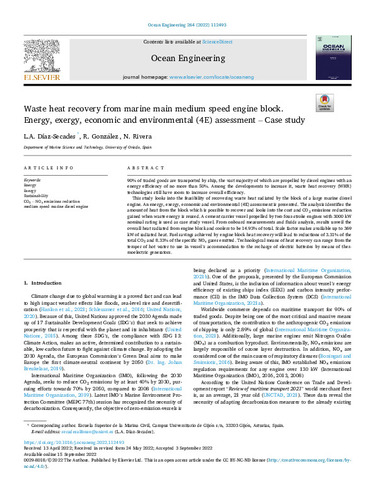Waste heat recovery from marine main medium speed engine block. Energy, exergy, economic and environmental (4E) assessment – case study
Subject:
Energy
Exergy
Marine diesel engine
Sustainability
Environmental science
Publication date:
Publisher version:
Citación:
Abstract:
90% of traded goods are transported by ship, the vast majority of which are propelled by diesel engines with an energy efficiency of no more than 50%. Among the developments to increase it, waste heat recovery (WHR) technologies still have room to increase overall efficiency. This study looks into the feasibility of recovering waste heat radiated by the block of a large marine diesel engine. An energy, exergy, economic and environmental (4E) assessment is presented. The analysis identifies the amount of heat from the block which is possible to recover and looks into the cost and CO2 emissions reduction gained when waste energy is reused. A cement carrier vessel propelled by two four-stroke engines with 3000 kW nominal rating is used as case study vessel. From onboard measurements and fluids analysis, results unveil the overall heat radiated from engine block and coolers to be 14.93% of total. Scale factor makes available up to 369 kW of radiated heat. Fuel savings achieved by engine block heat recovery will lead to reductions of 3.31% of the total CO2 and 8.33% of the specific NOx gases emitted. Technological means of heat recovery can range from the temper of hot water to use in vessel’s accommodation to the recharge of electric batteries by means of thermoelectric generators.
90% of traded goods are transported by ship, the vast majority of which are propelled by diesel engines with an energy efficiency of no more than 50%. Among the developments to increase it, waste heat recovery (WHR) technologies still have room to increase overall efficiency. This study looks into the feasibility of recovering waste heat radiated by the block of a large marine diesel engine. An energy, exergy, economic and environmental (4E) assessment is presented. The analysis identifies the amount of heat from the block which is possible to recover and looks into the cost and CO2 emissions reduction gained when waste energy is reused. A cement carrier vessel propelled by two four-stroke engines with 3000 kW nominal rating is used as case study vessel. From onboard measurements and fluids analysis, results unveil the overall heat radiated from engine block and coolers to be 14.93% of total. Scale factor makes available up to 369 kW of radiated heat. Fuel savings achieved by engine block heat recovery will lead to reductions of 3.31% of the total CO2 and 8.33% of the specific NOx gases emitted. Technological means of heat recovery can range from the temper of hot water to use in vessel’s accommodation to the recharge of electric batteries by means of thermoelectric generators.
ISSN:
Local Notes:
OA ATUO22
Collections
- Artículos [37321]
- Ciencia y Tecnología Náutica [29]
Files in this item





